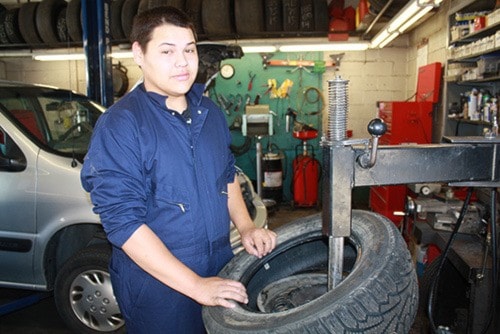It’s a sure sign that winter is creeping up on us, as snow tire season officially began in B.C. on October 1.
That’s the day when regulatory signage regarding snow tire useage becomes effective in the province. The signage is commonly seen on Highway 3 and 3A leading in and out of Keremeos.
Although winter tires are not mandatory in B.C., keep in mind that the Ministry of Transportation and Infrastructure can designate them to be required on certain roads and highways. This typically happens during the fall and winter months in northern B.C. and the southern Interior.
If you’re driving on these roads without winter tires, police can ticket you and make you turn back.
ICBC recommends winter tires because you are less likely to slide on the road. All season tires begin to lose their elasticity and grip on the road at temperatures below 7°C, according to Transport Canada.
At Keremeos tire shops, business is picking up as the annual tire swap takes place.
At K Mountain Auto, owner Sean Hitchen has been expanding his tire lines over the past few years and this year is offering expanded services to Keremeos residents. Now a Signature Tire Cente, Hitchen can also provide aluminum and steel rims as well as tire storage between seasons.
New to Ministry of Transportation and Infrastructure policy this year is the addition of “M&S” - mud and snow tires to the definition of snow tires. The regulation now reads as follows:
“Between October 1 and March 31, all passenger vehicles are required to use M+S or mountain/snowflake tires and all commercial trucks are required to carry chains on sections of most major highways.”
Driving without winter tires will not void a driver’s insurance if a claim is made, nor will it mean you’re automatically at-fault in a crash. However, if you get in a crash where winter tires could have helped, not having them may affect whether—or how much—you are at fault.
Lower Similkameen drivers should be aware of two signs in particular:
- a regulatory sign that says “Use winter tires or carry chains beyond this point October 1-April 30” when placed on a highway will prohibit vehicles from being driven or operated on a highway that are not equipped with winter tires or chains beyond that point when enforced by the police, ministry or other enforcement officials.
- a warning sign that says “Winter tires or carry chains October 1 - April 30” is placed on a highway to inform motorists that winter driving conditions can be expected, and motorists should therefore be properly equipped with appropriate winter safety equipment. Motorists not reasonably prepared may be prevented from proceeding on highways with this signage posted.
ICBC also recommends that all four wheels be equipped with winter tires. Studs are permitted between October 1 and April 30. Use of studded tires outside of this period may result in a fine.
Regulations limit tires to 130 studs each for vehicles weighing less than 4,600 kg, or 175 studs each for vehicles weighing more than 4,600 kg.
It’s important to note, drivers can only use studded tires on front wheels if they are also using them on rear wheels. This restriction on using studded tires on the front doesn’t apply to trucks that weigh more than 9,100 kg and can be equipped with snow plows.
